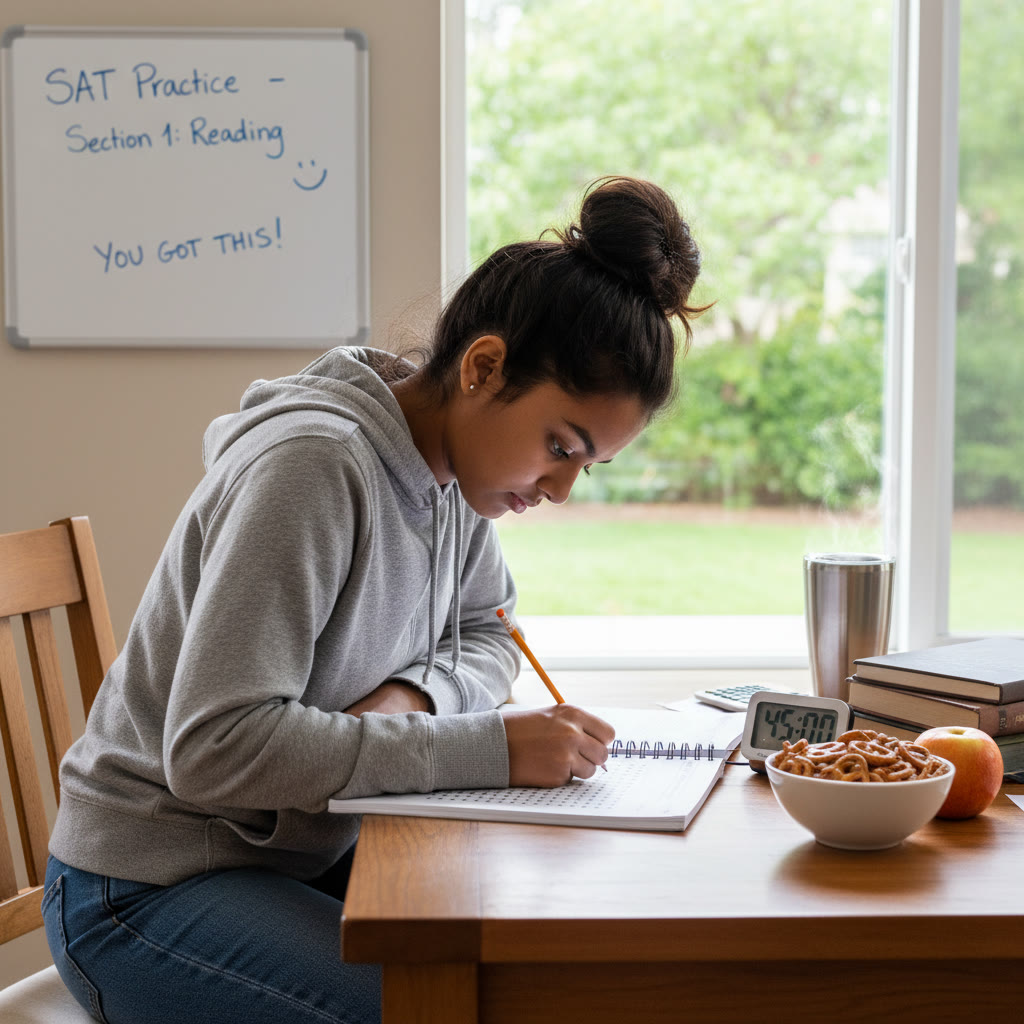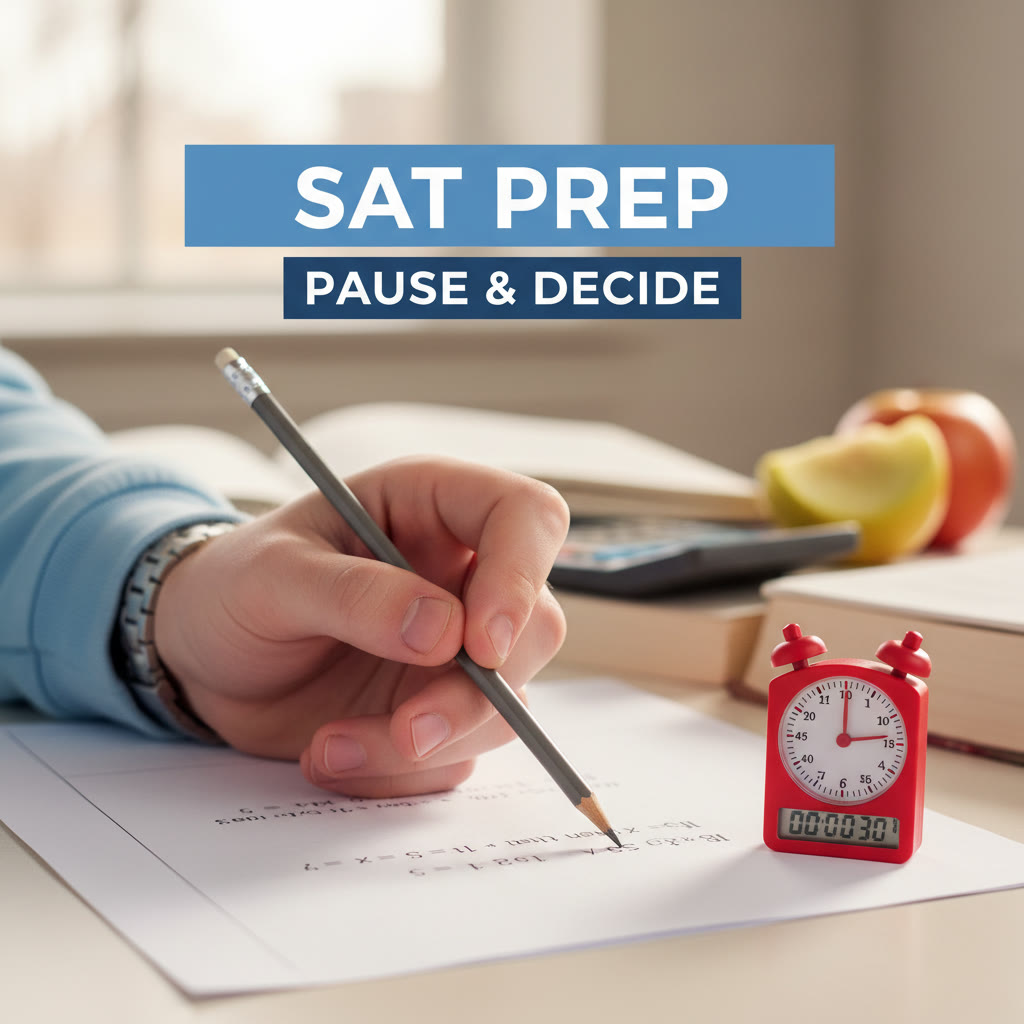Why practicing the SAT under time pressure isn’t optional — it’s essential
Think of the SAT like a sprint where you also need to solve puzzles mid-race. Raw knowledge matters — vocab, algebra rules, grammar conventions — but so does the ability to retrieve and apply that knowledge quickly and calmly. Practicing under time pressure builds the muscle that connects what you know to what you can reliably do in the three hours of test day.
This post walks through the why and the how: why timed practice changes outcomes, what precise pacing looks like across sections, concrete drills you can use, a sample 8-week plan, and how to make your practice smarter — including using Sparkl’s personalized tutoring for tailored pacing feedback, 1-on-1 guidance, and AI-driven insights when it fits naturally into your preparation.

What ‘time pressure’ really means on the SAT
When people say “timed practice,” they often mean sitting down with a stopwatch and taking a whole test. That helps, but time pressure operates at several levels:
- Pacing: average seconds per question and how you allocate them across passages or problem types.
- Stamina: maintaining accuracy and concentration over multiple sections and the full length of the test.
- Decision speed: knowing when to move on, when to guess, and when to dig deeper.
- Stress tolerance: performing while your heart rate and cortisol rise slightly — the test day reality.
All of these are trainable. The trick is to structure practice so each session targets one or more of those layers rather than just repeating long untimed drills.
Concrete timing facts: how much time do you actually have?
Understanding the math behind the clock is liberating. Here’s a practical table that shows the official section times, question counts, and the average seconds available per question. Use these figures to shape your micro-timing targets.
| Section | Time | Questions | Average seconds/question |
|---|---|---|---|
| Reading | 65 minutes | 52 | ~75 seconds |
| Writing & Language | 35 minutes | 44 | ~48 seconds |
| Math (No Calculator) | 25 minutes | 20 | ~75 seconds |
| Math (Calculator) | 55 minutes | 38 | ~87 seconds |
These averages are useful, but smart pacing is not strictly about hitting the same seconds per question. Some Reading passages demand longer per question; some Math problems you can blitz quickly. The point: know the averages so you can recognize when you’re falling behind.
Quick example: the Reading passage
Imagine a 10-question Reading passage. If you spend two minutes on the first two questions, you’ve used up 4 minutes of the ~12.5 minutes you should budget for the whole passage. That makes it much harder to finish without hurried mistakes. Timed practice trains you to recognize which questions deserve extra time and which should be flagged and returned to if you have it.
Top benefits of practicing under time pressure
1. Faster recall and decision-making
Time pressure forces you to build a reliable retrieval process. Instead of leisurely working toward an answer, you train your brain to recognize patterns — question types, grammar traps, algebra shortcuts — and execute a quick checklist to get to the answer faster.
2. Better pacing instincts
Many students either race through early questions and burn out, or they get stuck and leave doable questions unanswered. Timed practice develops an intuitive sense of when to move on and when to dive deeper.
3. Reduced test-day anxiety
Stress is partly fear of the unknown. If you’ve simulated ticking clocks, the ambient pressure of a live test feels less foreign. Timed practice conditions not just skill but confidence: you’ve done this before and survived.
4. Clearer diagnostic signals
An untimed test hides weaknesses. If your raw accuracy without time constraints is high but your timed accuracy plummets, you know the problem is pace rather than content. That precision lets you target practice efficiently — something Sparkl’s tutors and AI analytics specialize in when shaping tailored study plans.
5. Improved stamina and focus
The SAT is a long exam. Timed practice teaches you to maintain stamina so your brain can keep producing quality answers in hour three the same way it did in hour one.
How to practice under time pressure — a step-by-step roadmap
Timely practice should feel purposeful, not punishing. Here’s a progression you can follow, whether you have 4 weeks or 12 weeks until test day.
- Step 1 — Baseline, untimed, and diagnostic (first week): Take a complete, untimed practice test to identify content gaps and typical timing bottlenecks. Compare untimed vs timed scores to see where pressure costs you points.
- Step 2 — Section-timed drills: Instead of starting with full-lengths, practice each section under official time. Do multiple Reading passages or two Writing sections back to back, focusing only on hitting time and tracking accuracy.
- Step 3 — Micro-timing drills: Time per passage or per problem. For Reading, set a limit per passage (e.g., 12 minutes for a 10-question passage). For Math, time problem sets by difficulty (e.g., 5 questions in 7 minutes).
- Step 4 — Full-length timed tests: Simulate test day with full sections, breaks, and a realistic environment. Do this weekly or biweekly as your test approaches.
- Step 5 — Post-test analysis: Always review timed tests meticulously. For every mistake, record whether it was content, careless, or timing-related. Use these labels to adjust practice.
Sample micro-drills you can use today
- Reading 10×10 drill: 10 short passages, 10 minutes each — practice focusing for short bursts and finishing cleanly.
- Math triage set: 20 mixed problems in 25 minutes; mark 6 problems to revisit and finish if time allows.
- Writing speed set: 44 questions in 35 minutes, but stop after 30 minutes and review the last 5 answers quickly — this simulates running low on time.
Common timing mistakes and how to fix them
Mistake: Treating every question the same
Fix: Prioritize. On Reading, answer the easier question types first (line reference, main idea identification) and flag inference-heavy ones for return. In Math, do algebra and straightforward geometry first; leave multi-step word problems until later.
Mistake: Not marking questions to come back
Fix: Develop a simple marking system — star, circle, or pencil mark — and practice scanning your test to pick up flagged items quickly. This saves time and prevents revisiting the same thought process twice.
Mistake: No timing checkpoints
Fix: Break a section into chunks with target checkpoints. For example, for Reading: after two passages, you should be around the 25-minute mark. If you’re behind, speed up strategy rather than panicking.
Real-world example: Maya’s turnaround
Maya was sitting on practice tests with good untimed accuracy but a 100-point gap under timed conditions. She was meticulous but slow. Her tutor suggested a two-week micro-timing intervention: timed Reading passages (12 minutes each), math triage sets, and weekly full-lengths.
She also used Sparkl’s personalized tutoring for targeted 1-on-1 sessions that tracked where she lost time and why. Tutors helped build a simple set of heuristics (e.g., skip any Reading question requiring a paragraph-length evidence hunt on the first pass). With two weeks of practice, Maya’s timed accuracy improved, and she regained time by skipping and confidently returning to the hardest problems. Her official score jump reflected not new knowledge but smarter, faster application.
How to analyze timed practice to make it stick
Timed practice is only as good as your analysis. After any timed session, ask three questions:
- Which mistakes were content gaps? (I genuinely didn’t know the rule.)
- Which mistakes were careless? (I misread an answer because I rushed.)
- Which mistakes were timing-related? (I guessed because I ran out of time.)
Label each missed question accordingly. If timing-related errors dominate, reduce per-question depth and practice speed. If content gaps dominate, schedule targeted reviews. Sparkl’s tailored study plans and AI-driven insights can help prioritize these categories so you spend time where it yields the most score improvement.
A practical 8-week timed practice plan (example)
This plan assumes a baseline of moderate content knowledge and aims to combine content work with timed practice and full-length sims. Adjust the hours per week to fit your schedule.
| Week | Focus | Timed practice | Other work |
|---|---|---|---|
| 1 | Diagnostic & baseline | Untimed baseline test; 1 section timed | Review content gaps; set goals |
| 2 | Section pacing | Daily section-timed drills (Reading/W&L/Math) | Targeted content review 3x/week |
| 3 | Micro-timing | Passage-by-passage timed Reading; Math triage sets | One tutor session to refine strategy |
| 4 | Full-length simulation | 1 full-length timed test | Detailed review of errors |
| 5 | Strategy refinement | Timed drills focused on weak areas | Practice with calculator/no-calculator alternation |
| 6 | Stamina building | Two full-lengths (one timed, one slightly faster pacing) | Breathing and focus routines |
| 7 | Polish | Section timed practice; fewer full lengths | Mock-test day routine practice |
| 8 | Test week | Light timed practice; one final full-length 6 days out | Rest, sleep, logistics |
Note: Personalization matters. If you’re weaker in Math, emphasize Math triage sets and work with a tutor to adjust pacing for multi-step questions. That’s where Sparkl’s 1-on-1 guidance, tailored study plans, and expert tutors can make a natural difference: they help convert timed practice into higher expected scores by pinpointing where time is lost.
Stress, breathing, and small rituals that keep time pressure productive
Time pressure is not just a clock; it’s a physical state. A few small habits keep that state from becoming destructive:
- Practice controlled breathing for 30 seconds if you feel stuck — inhale for 4, hold 2, exhale 6. It resets focus fast.
- Use the first 30 seconds of each section to scan and set a pacing checkpoint — know where you want to be halfway through.
- Have a simple snack and hydration plan for breaks on full-lengths to maintain glucose and attention.
These tiny rituals are part of timed practice. Over time they become automatic and free cognitive bandwidth for solving problems instead of worrying about the clock.
When timed practice can go wrong (and how to course-correct)
Timed practice can feel demoralizing if you treat every timed test as a final. If you see slow progress or increased anxiety, try these fixes:
- Scale back intensity: do section-timed work rather than full-lengths until your pacing improves.
- Pair timed practice with targeted, untimed review: practice fast, then spend calm time fixing the reasoning behind mistakes.
- Work with a tutor for technique and mindset coaching. A good coach helps you interpret timed practice results and creates a plan to improve — Sparkl’s personalized tutoring offers exactly that kind of guidance when students need it.
How to use technology and coaching without losing the human edge
Apps and timers are useful, as are score calculators and analytics dashboards. But numbers alone don’t tell you the story. Combine automated insights with human feedback:
- Use analytics to spot patterns (e.g., “I lose time on inference questions”) and then talk through those patterns with a tutor or study partner.
- Record one full-length test-run and review your pacing choices out loud — hearing your reasoning clarifies bad habits.
- If you use an AI-driven tutoring platform or coach, ask for targeted pacing drills and weekly adjustments to your plan rather than generic advice.
Sparkl’s approach blends expert tutors with AI-driven insights so your timed practice is always evolving based on what actually costs you points.
Final checklist: making timed practice effective
- Simulate real conditions regularly: same time limits, quiet environment, and realistic breaks.
- Track per-question time in sections until you intuitively know whether you’re on pace.
- Prioritize drills that expose timing weaknesses rather than only content weaknesses.
- Analyze every timed session: label errors as content, careless, or timing-related.
- Use coaching to convert timed practice into actionable improvements — tailored tutoring and 1-on-1 feedback speed this process up.
Closing thoughts: pace builds power
Doing the math — literally and figuratively — on the SAT reveals a simple truth: speed and accuracy are partners, not enemies. Practicing under time pressure trains your brain to access knowledge faster, make smarter decisions about when to move on, and hold calm when the clock is ticking. That training doesn’t erase the need for content mastery, but it amplifies it.
If timed practice feels overwhelming, remember: improvements are usually incremental. Start with section-timed drills, track what you learn, and make small changes weekly. If you want a personalized touch to maximize the value of every timed session, consider 1-on-1 guidance, tailored study plans, and AI-driven feedback — resources like Sparkl can fit naturally into a preparation routine and help turn practice minutes into measurable score gains.
On test day, the clock will be the same for everyone. Who wins is often the student who practiced not just what to solve — but when and how fast to solve it.














No Comments
Leave a comment Cancel